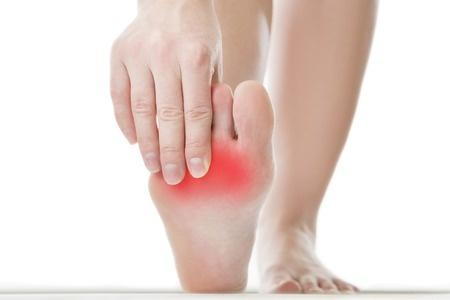After a long day of sports training or walking around in high heels, the balls of your feet may hurt. Unless you bring other shoes to change into, the route home can seem so long that you may be tempted to take your shoes off and go barefoot. So what’s going on? 
Pain in the balls of your feet is generally referred to as metatarsalgia. The five bones between the toes and the arch are called the metatarsals. When one or more of the joints involving those bones becomes affected, it can become inflamed and cause you pain. People who repeatedly put pressure on the metatarsal joints may notice a callus there.
What can cause metatarsalgia?
-
Uncomfortable and unsupportive shoes – Women who wear a lot of high heels will often notice this type of pain because they bear most of their weight on the balls of the feet while walking. Additionally, when anyone wears shoes that do not have good arch support or have toe boxes that are too narrow, it can cause irritation to the metatarsals. Poorly fitting shoes can also cause other issues like foot deformities that can put pressure on your metatarsals.
-
Intense training or exercise – Any activity that includes impact on the feet (e.g. walking or jumping) risks pain because of the forces that the midfoot endures.
-
Other conditions: Stress fractures, Morton’s Neuroma, Arthritis, Obesity – If you have trauma or repeated injury, you can develop broken or fractured bones that alters your gait in a way that applies pressure on the feet. Additionally, Morton’s Neuroma affects the third and fourth toes, with extra fibrous tissue growing around the nerve in the metatarsals that could cause pain. Furthermore, because arthritis affects the joints, the metatarsal joints are subject to arthritic pain. Finally, being overweight can also make you put more pressure at the forefoot, applying more pressure on the metatarsals.
How to ease pain
Because metatarsalgia is more of a condition to describe the pain in the ball of the feet, pain relief includes symptom management. In most cases, the RICE method (rest, ice, compression, elevation) can help after a day of walking or exercise. Changing to more supportive and shoes can also help prevent and relieve symptoms. Some orthotics (like metatarsal pads) may be in order for those with deformities or pain from shoes, especially if you have specific work shoes that need to be worn.
When these treatments do not work, you may need to check for other conditions that may be contributing to metatarsalgia. If foot deformities like hammertoes are causing pain, surgery to correct that issue may be required. To find the best solution, consult with our board-certified podiatrist, Dr. Brad Toll at Crofton Podiatry. Make an appointment by calling (410) 721-4505. Our team is ready to assist you and your family at our Crofton, MD office, which also serves the surrounding Gambrills, Odenton, and Bowie areas.
